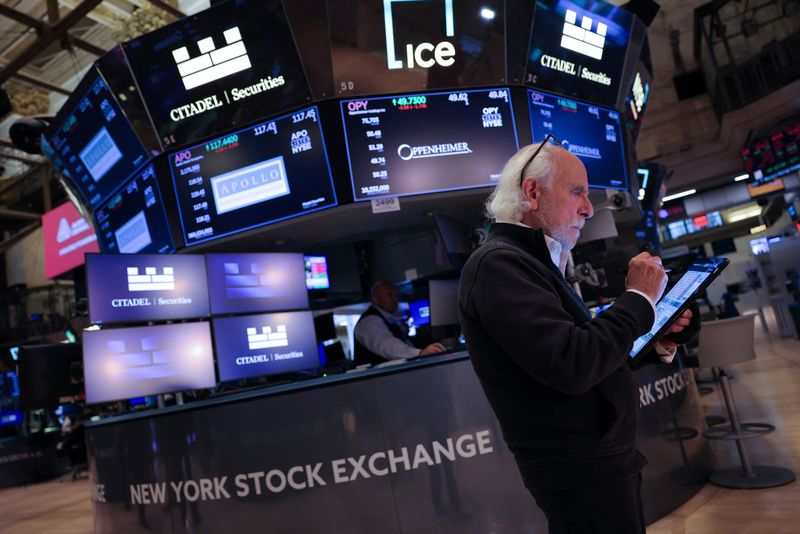By David French
(Reuters) -Wall Street’s benchmarks finished up on Tuesday, recouping some of the previous session’s losses, as investors bought back in to technology stocks and investors shifted their focus to upcoming inflation data and the start of third-quarter earnings season.
All three of the main indexes suffered a sell-off on Monday, falling roughly 1% each, as they were pressured by surging Treasury yields, escalating Middle East tensions, and a re-evaluation of U.S. rate expectations.
The easing of Treasury yields somewhat on Tuesday, however, meant investors were drawn to high-growth stocks, which benefit from lower debt costs to fuel their growth, such as technology companies.
The information technology index led gainers among the S&P 500 sectors, jumping 2.1%. It was aided by advances of 6.6% and 5.1%, respectively, by Palantir Technologies (NYSE:PLTR) and Palo Alto Networks (NASDAQ:PANW).
Heavyweight tech names were also buoyant, helping to push both the Nasdaq and the S&P 500 back above levels they finished at last week – albeit fractionally, in the case of the latter.
Nvidia (NASDAQ:NVDA) was the pick of the so-called Magnificent Seven tech stocks, climbing 4.1% for its largest one-day percentage increase in a month. There were also gains for Apple (NASDAQ:AAPL), Tesla (NASDAQ:TSLA) and Meta Platforms (NASDAQ:META), which all rose between 1.4% and 1.8%.
On Tuesday, the S&P 500 rose 55.19 points, or 0.97%, to 5,751.13 points, while the Nasdaq Composite climbed 259.01 points, or 1.45%, to 18,182.92. The Dow Jones Industrial Average gained 126.13 points, or 0.30%, to 42,080.37.
While the abatement of rising Treasury yields helped tech stocks, it is still interest rate policy that is guiding traders and the U.S. equity markets.
Investors have been locked in all year on the U.S. Federal Reserve and how it plans to deliver its long-expected bout of interest rate cuts, with each new economic data set studied for how it could influence the thinking of the central bank.
Last week’s data releases, including Friday’s stronger-than-expected jobs report, had prompted investors to trim their rate cut bets slightly, albeit leaning more toward a 25 basis-point cut at the next Fed meeting in November, as opposed to 50 bps.
Traders have now priced in a nearly 89% chance of a 25 basis-point interest rate cut in November, according to CME FedWatch.
Markets now await consumer price index data, due this Thursday, for the next signpost on the path of interest rates.
“I do think (Friday’s) labor market report, and the CPI report combined, are the two primary items for the Federal Reserve heading in to their next meeting,” said Jason Pride, chief of investment strategy and research at Glenmede.
He added that if the CPI lands anywhere in the ballpark of what is expected, that would portend a 25 bps November cut.
Most S&P sectors gained, although two ended in negative territory. One was the materials sector, which fell 0.4% as metal prices slipped on waning optimism over China’s stimulus measures.
U.S.-listed shares of Chinese companies also slid, tracking losses in domestic stocks. Shares of Alibaba (NYSE:BABA) Group, JD (NASDAQ:JD).com and PDD Holdings slumped between 5.4% and 7.5%.
Energy was the heaviest decliner though, slipping 2.6% in its biggest one-day loss since Aug. 20, as oil prices retreated following Monday’s rally. [O/R]
Third-quarter earnings are also coming in to focus, with major banks scheduled to report this Friday. The estimated earnings growth rate for the S&P 500 is 5%, according to LSEG estimates.

PepsiCo (NASDAQ:PEP) gained 1.9% after the snack maker trimmed its forecast for annual sales growth, but reported adjusted earnings per share above estimates.
Volume on U.S. exchanges was 11.57 billion shares, compared with the 12.1 billion average for the full session over the last 20 trading days.











